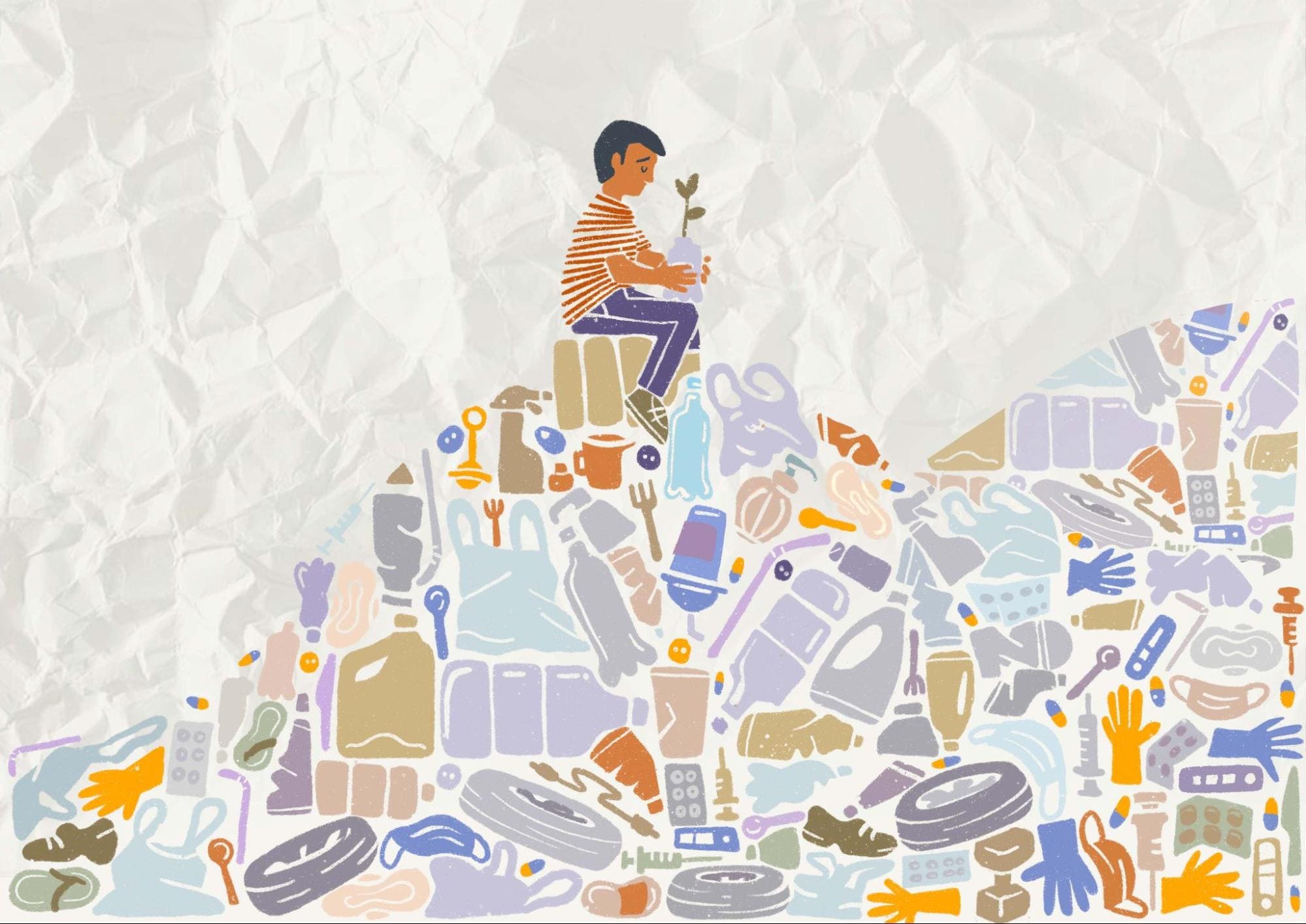
Illustrated by Himanshi Parmar
Have you ever driven past a landfill, or even googled pictures, only to be shocked at how big they really are? How we get rid of our trash isn’t something we consciously think about every day, but with rising environmental concerns, is it time to start?
One of the leading contributors to waste has been plastics. We use plastics every day, tripling global resource consumption in the last 50 years. Unfortunately, in those 50 years, only nine percent of all plastics have been recycled.
There are a number of different plastics we use every day and the difficulty of recycling ranges. The easiest plastics to recycle are PET and HDPE. These plastics are what most of our water bottles, food containers, laundry detergent bottles, and household cleaning bottles are made up of. PET plastic that goes into our water bottles can be recycled into another water bottle or even spun into the fabric to make clothes! HDPE plastics that are used for most non-food application bottles, can be recycled into several things such as plastic lumber, tables, and speedbumps. Other plastics like LDPE and PP plastics are more difficult to recycle. These are the plastics we use to make packaging materials and the plastic bags you see at the grocery store. These plastics tangle in machinery and are more expensive to recycle, making them less likely to be given another life.

With all these plastics, it's hard to know how to help cut back and what plastics can be reused. Outside of recycling, the best way to cut back on the number of plastics ending up in landfills is to cut down on single-use plastics overall. This doesn't have to mean big changes in how you function every day. Simple changes such as buying a reusable water bottle, reusable shopping bags, and buying products from sustainable brands that limit their single-use plastics can make all the difference!
When it comes to throwing out our trash, we don't usually sit around and wonder where it goes. However, landfills are beginning to make large changes in the quality of our air, land, and water. There are several different types of landfills that range in types of materials and how they’re disposed of.
- Sanitary landfills - waste sits in piles or is buried underground until it has completely decomposed
- Municipal solid waste landfills - Specifically designed to receive household waste, as well as other types of non-hazardous wastes
- Construction and demolition waste landfills - concrete, wood, asphalt, gypsum (the main component of drywall), metals, bricks, glass, plastics, trees, stumps, earth, rock, and building components
- Industrial waste landfills - Designed to collect commercial and institutional waste (i.e. industrial waste), which is often a significant portion of solid waste, even in small cities and suburbs. not used for the disposal of solid waste
- Toxic waste landfills - Facilities used specifically for the disposal of hazardous waste
As landfills decompose, several different gases can be released into the air we breathe. These gases can contribute to lung cancer and climate change. The decomposition process can also be hazardous to our drinking water and soil. It is not uncommon for materials to leak into the soil, causing land to become contaminated along with occasionally seeping into the water we drink.
Other countries such as India, South Korea, and Europe have recycling rates higher than 50%, so why is it that the U.S. keeps falling so short? In countries such as the UK, a landfill tax is put in place to help reduce the amount of waste and help create a more circular economy. Since the implementation of this tax, landfill waste in the UK has been reduced by over 38 million tons! In fact, most countries in Europe have imposed some sort of landfill tax that has helped cut back on overall waste. On top of imposing a tax on all products sent to landfills, these countries are also known to pay more to citizens for recycled products.

This encourages citizens to recycle and compost when possible, and get paid for their trash rather than having to pay for it. While the United States has several laws and regulations surrounding the operation of landfills, there are no federal taxes put in place for the disposal of products. With the success of landfill taxes in other countries, we have to wonder if the U.S. would succeed in cutting back on landfill waste if a similar tax was put in place.

Let’s stop and think about how that would affect everyday trash. If we were charged for every square foot of garbage we simply threw out to be sent to a landfill, we would all be more conscious about what we’re throwing out. If in turn, we could get paid for our recyclables instead of having to pay for their disposal, most Americans would opt to recycle more and waste less.
While landfill taxes aren't currently being implemented in the United States, millions of pounds of waste is overflowing our landfills and affecting our lives every day, even if we may not directly take notice. Being more conscious about how we dispose of our trash can make all the difference. By learning to compost, recycling materials when possible, and cutting back on single-use plastics, we may be able to help the next generation have a more sustainable future, and help create a more circular economy.